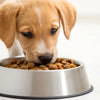What to Feed a Puppy When Out of Dog Food: A Comprehensive Guide for Pet Owners
- Houndsy
Table of Contents
- Introduction
- Understanding Nutritional Needs
- Safe Human Food Alternatives
- Foods to Avoid
- Preparing a Balanced Meal
- When to Transition Back to Regular Dog Food
- Conclusion
- FAQ
Introduction
As pet owners, we craft enchanting experiences filled with cuddles, playtime, and those adorable puppy stares that melt our hearts. Yet, in the hustle and bustle of our lives, we all have that sinking moment—opening the pantry or the cupboard and finding out that the dog food is empty. According to a survey by the American Pet Products Association, nearly 70% of households in the U.S. have pets, meaning many of us could face this dilemma. So what do we do when our furry companions rely on us, and our usual kibble is nowhere to be seen?
In this blog post, we will navigate through the solutions and tips for feeding your puppy when you're out of dog food. We will explore safe human food alternatives that provide essential nutrients temporarily, discuss how to create balanced meals quickly, and highlight the importance of transitioning back to regular dog food for long-term health. By the end, you’ll gain insights into how to ensure your pup's nutritional needs are met even in a pinch while examining how to structure their meals for the best health outcomes.
Let us dive deep into various safe options and create peace of mind for you and your beloved pet when unexpected situations arise.
Understanding Nutritional Needs
Dogs as Omnivores
Before we dive into specific food suggestions, it's essential to understand that dogs are omnivorous animals—meaning they thrive on a variety of foods including meats, vegetables, and grains. However, their nutritional needs differ greatly from ours. Dogs require specific protein levels, sufficient fats, vitamins, and minerals while avoiding harmful ingredients. Thus, the key to success lies in selecting the right human food that can replace or supplement their regular diet when necessary.
Daily Nutritional Requirements
A puppy's diet should ideally consist of about 18-25% protein and 5-8% fat. Considering these requirements helps us understand what to look for when feeding them human food.
Transitioning Between Meals
It's critical to note that changing your puppy’s diet abruptly can lead to gastrointestinal distress. This means that while preparing a temporary meal, we must aim for balance. If you know you'll be running out of dog food, it’s wise to incorporate small amounts of human food in their diet leading up to that moment.
Safe Human Food Alternatives
Lean Proteins
-
Cooked Chicken: This is a classic alternative. Simply boil or bake chicken breast without seasoning or skin, ensuring that it's boneless. Chicken is rich in protein and easy for dogs to digest.
-
Ground Beef: Lean ground beef can also be an option. Cook it thoroughly and drain any excess fat before serving it to your pup.
-
Eggs: Fully cooked eggs are safe and nutritious. Scramble them without butter or seasoning for an easy meal.
-
Fish: Cooked salmon or tuna can be extremely beneficial, thanks to the omega-3 fatty acids, which support skin and coat health. Just ensure the fish is deboned and prepared without any additives.
Carbohydrates and Grains
-
Rice: Plain, cooked white rice is often recommended for upset stomachs, but it can serve as a great filler for meals too.
-
Quinoa: A protein-rich grain that can be offered in small portions.
-
Oatmeal: This is a good source of soluble fiber and can help with digestive health.
-
Pasta: Plain, cooked pasta can round out a meal, offering carbs in a form that isn't hard on the stomach.
Fruits and Vegetables
-
Pumpkin: Plain pumpkin (canned or cooked) is an excellent option for dietary fiber. It can help settle your dog's stomach and regulate their digestive system.
-
Carrots: Raw or cooked, carrots are perfect as a crunchy snack or side.
-
Green Beans: These can be served raw or cooked and are low in calories while being packed with nutrients.
-
Apples: Remove the core and seeds; apples are a fresh treat that can aid digestion and provide some vitamins.
-
Blueberries: These tiny powerhouses are high in antioxidants and can be a healthy snack for your furry friend.
Temporary Feeding Guidelines
-
Aim for a two-to-one ratio of protein to carbohydrate when making a substitute meal. For example, combine two cups of cooked chicken with one cup of rice.
-
Always ensure that the ingredients are cooked plainly without any seasoning, oils, or additives.
-
Be mindful of allergy triggers. If you know your puppy has specific allergies, avoid those entirely.
-
Consider consulting your veterinarian for advice on dietary needs specific to your puppy's breed, size, or health conditions.
Foods to Avoid
While we’ve covered several safe options, it's equally crucial to know which foods are toxic or harmful to dogs:
-
Chocolate: This is highly toxic and must be avoided at all costs.
-
Grapes and Raisins: Can lead to acute kidney failure and should never be given.
-
Onions and Garlic: These can damage red blood cells and cause anemia.
-
Avocados: Contain persin, which is harmful to pets.
-
Nuts: Especially macadamia nuts—can cause severe health issues.
-
Dairy: While some dogs can tolerate small amounts, many have lactose intolerance which can lead to digestive upset.
Preparing a Balanced Meal
Cooking at Home
If you find yourself needing to prepare dog food at home, start simple. You can mix and match ingredients based on availability. For instance, combining chicken, rice, and green beans creates a wholesome meal.
- Recipe example: A combination of 1 cup of plain boiled chicken, 1 cup of rice, and half a cup of cooked carrots makes a filling meal.
Using Broth for Flavor
Broth (low-sodium chicken or beef) can be incorporated into meals for extra flavor. Additionally, drizzling it over food can mask the unfamiliarity when introducing new ingredients.
When to Transition Back to Regular Dog Food
While offering temporary meals is useful, we must remember that home-cooked meals typically lack the complete nutrition of a high-quality commercial dog food. Ideally, you should transition back to your regular dog food as soon as possible, usually within a few days, because:
- Commercial dog food is formulated to meet specific dietary needs.
- Prolonged homemade diets can lead to deficiencies—especially if certain critical nutrients are missing.
To transition back smoothly, start by mixing a small quantity of your regular dog food into the homemade meals, gradually increasing its portion.
Conclusion
Running out of dog food doesn’t have to lead to panic. There are options available right in your kitchen that can keep your puppy happy and well-fed until you can restock their kibble supply. By understanding their nutritional needs, recognizing safe human food alternatives, and cooking with care, we can provide temporary meals that satisfy our furry companions.
As nurturing pet owners, we know that keeping our pups healthy and happy is our top priority. Investing in a reliable feeding routine, like the Houndsy Kibble Dispenser, can help prevent the common anxiety of running out of dog food by keeping stock organized and ensuring meal portions are perfect every time. Explore more about enhancing your puppy's feeding experience with us here.
FAQ
Can I give my dog human food every day?
While occasional human food is generally accepted, it's crucial to transition back to a balanced commercial diet. Providing regular human food can lead to nutritional imbalances.
How can I tell if my dog has allergies to specific foods?
Look for symptoms such as excessive scratching, digestive issues, or changes in behavior. Consult your vet to conduct tests on potential food allergies.
What's the best way to transition back to dog food?
Mix regular dog food with human foods gradually after a few days on temporary meals, increasing the ratio of existing dog food to home-cooked meals over several days.
Are there any specific DIY dog food recipes?
Yes, combining lean protein sources (like chicken or turkey) with grains (like rice or quinoa) and veggies (like peas or carrots) creates a wholesome meal. Just ensure to follow balanced ratios.
Should I include bones in my dog's homemade meal?
Never include cooked bones, as they can splinter and pose serious risks to your dog. Raw bones can also carry bacteria and should be approached with caution.
Keep the journey with your four-legged friend joyful and nutritious, and remember that good preparation means fewer stressful moments in the future!












